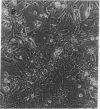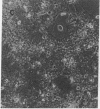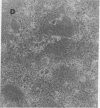Abstract
16, 16 Dimethyl prostaglandin E2 (dmPGE2), a known cytoprotective agent, was examined for its ability to alter the course of fulminant hepatitis in an experimental model of fulminant viral hepatitis, murine hepatitis murine hepatitis type 3 (MHV-3). Fully susceptible BALB/cJ mice, infected with 100 50% lethal doses (LD50) of MHV-3 developed histologic and biochemical evidence of fulminant hepatitis, as evidenced by massive hepatic necrosis with hypoglycemia, metabolic acidosis, and a markedly elevated serum alanine aminotransferase (ALT) (mean, 1,402 +/- 619 IU/liter). In contrast, animals treated with dmPGE2 either before or after infection (up to 48 h) demonstrated a marked reduction in both histologic and biochemical evidence of liver damage as characterized by normal blood glucose, total CO2, and ALT determinations (mean ALT, 63 +/- 40 IU/liter). Treatment of infected mice with PGF2 alpha demonstrated no cytoprotective effects. High titers of infectious virus were recovered from the livers of both dmPGE2-treated and -untreated animals throughout the course of infection. In a parallel in vitro study, dmPGE2 (10(-4)-10(-8) M) demonstrated a similar cytoprotective effect on monolayers of isolated cultured hepatocytes from fully susceptible BALB/cJ mice infected at a multiplicity of infection of 0.1, 1.0, and 10.0. In addition, splenic macrophages recovered from infected and untreated BALB/cJ mice demonstrated a marked augmentation in procoagulant activity (PCA) from a basal 10 +/- 5 mU/10(6) splenic macrophages to a maximum of 615 +/- 102 mU/10(6) splenic macrophages, whereas no increase in macrophage PCA was detected in infected animals treated with dmPGE2. These results suggest that dmPGE2, without detectably altering viral replication or infectivity in vivo, confers a marked cytoprotective effect on hepatocytes both in vivo and in vitro, and prevents the induction of macrophage PCA in vivo in fully susceptible BALB/cJ mice after murine hepatitis virus type 3 infection.
Full text
PDF








Images in this article
Selected References
These references are in PubMed. This may not be the complete list of references from this article.
- Arnheiter H., Baechi T., Haller O. Adult mouse hepatocytes in primary monolayer culture express genetic resistance to mouse hepatitis virus type 3. J Immunol. 1982 Sep;129(3):1275–1281. [PubMed] [Google Scholar]
- Bernuau J., Rueff B., Benhamou J. P. Fulminant and subfulminant liver failure: definitions and causes. Semin Liver Dis. 1986 May;6(2):97–106. doi: 10.1055/s-2008-1040593. [DOI] [PubMed] [Google Scholar]
- Bond C. W., Leibowitz J. L., Robb J. A. Pathogenic murine coronaviruses. II. Characterization of virus-specific proteins of murine coronaviruses JHMV and A59V. Virology. 1979 Apr 30;94(2):371–384. doi: 10.1016/0042-6822(79)90468-9. [DOI] [PMC free article] [PubMed] [Google Scholar]
- Clegg P. C. Antagonism by prostaglandins of the responses of various smooth muscle preparations to sympathomimetics. Nature. 1966 Mar 12;209(5028):1137–1139. doi: 10.1038/2091137b0. [DOI] [PubMed] [Google Scholar]
- Cole E. H., Cardella C. J., Schulman J., Levy G. A. Monocyte procoagulant activity and plasminogen activator. Role in human renal allograft rejection. Transplantation. 1985 Oct;40(4):363–371. doi: 10.1097/00007890-198510000-00005. [DOI] [PubMed] [Google Scholar]
- Cole E. H., Schulman J., Urowitz M., Keystone E., Williams C., Levy G. A. Monocyte procoagulant activity in glomerulonephritis associated with systemic lupus erythematosus. J Clin Invest. 1985 Mar;75(3):861–868. doi: 10.1172/JCI111784. [DOI] [PMC free article] [PubMed] [Google Scholar]
- Dave J. R., Knazek R. A. Prostaglandin I2 modifies both prolactin binding capacity and fluidity of mouse liver membranes. Proc Natl Acad Sci U S A. 1980 Nov;77(11):6597–6600. doi: 10.1073/pnas.77.11.6597. [DOI] [PMC free article] [PubMed] [Google Scholar]
- Dindzans V. J., MacPhee P. J., Fung L. S., Leibowitz J. L., Levy G. A. The immune response to mouse hepatitis virus: expression of monocyte procoagulant activity and plasminogen activator during infection in vivo. J Immunol. 1985 Dec;135(6):4189–4197. [PubMed] [Google Scholar]
- Dupuy J. M., Levey-Leblond E., Le Prevost C. Immunopathology of mouse hepatitis virus type 3mii. effect of immunosuppression in resistant mice. J Immunol. 1975 Jan;114(1 Pt 1):226–230. [PubMed] [Google Scholar]
- Geczy C. L., Meyer P. A. Leukocyte procoagulant activity in man: an in vitro correlate of delayed-type hypersensitivity. J Immunol. 1982 Jan;128(1):331–336. [PubMed] [Google Scholar]
- Geczy C. L., Roberts I. M., Meyer P., Bernard C. C. Susceptibility and resistance to experimental autoimmune encephalomyelitis and neuritis in the guinea pig correlate with the induction of procoagulant and anticoagulant activities. J Immunol. 1984 Dec;133(6):3026–3036. [PubMed] [Google Scholar]
- Giron D. J. Inhibition of viral replication in cell cultures treated with prostaglandin E1. Proc Soc Exp Biol Med. 1982 May;170(1):25–28. doi: 10.3181/00379727-170-41390. [DOI] [PubMed] [Google Scholar]
- HENRY R. J., CHIAMORI N., GOLUB O. J., BERKMAN S. Revised spectrophotometric methods for the determination of glutamic-oxalacetic transaminase, glutamic-pyruvic transaminase, and lactic acid dehydrogenase. Am J Clin Pathol. 1960 Oct;34:381–398. doi: 10.1093/ajcp/34.4_ts.381. [DOI] [PubMed] [Google Scholar]
- Harbour D. A., Blyth W. A., Hill T. J. Prostanglandins enhance spread of herpes simplex virus in cell cultures. J Gen Virol. 1978 Oct;41(1):87–95. doi: 10.1099/0022-1317-41-1-87. [DOI] [PubMed] [Google Scholar]
- Hirano N., Fujiwara K., Hino S., Matumoto M. Replication and plaque formation of mouse hepatitis virus (MHV-2) in mouse cell line DBT culture. Arch Gesamte Virusforsch. 1974;44(3):298–302. doi: 10.1007/BF01240618. [DOI] [PubMed] [Google Scholar]
- Lahmy C., Virelizier J. L. Prostaglandins as probable mediators of the suppression of antibody production by mouse hepatitis virus infection. Ann Immunol (Paris) 1981 Jan-Feb;132C(1):101–105. doi: 10.1016/0769-2625(81)90010-6. [DOI] [PubMed] [Google Scholar]
- Le Prevost C., Levy-Leblond E., Virelizier J. L., Dupuy J. M. Immunopathology of mouse hepatitis virus type 3 infection. Role of humoral and cell-mediated immunity in resistance mechanisms. J Immunol. 1975 Jan;114(1 Pt 1):221–225. [PubMed] [Google Scholar]
- Levin J., Poore T. E., Young N. S., Margolis S., Zauber N. P., Townes A. S., Bell W. R. Gram-negative sepsis: detection of endotoxemia with the limulus test. With studies of associated changes in blood coagulation, serum lipids, and complement. Ann Intern Med. 1972 Jan;76(1):1–7. doi: 10.7326/0003-4819-76-1-1. [DOI] [PubMed] [Google Scholar]
- Levin J., Poore T. E., Zauber N. P., Oser R. S. Detection of endotoxin in the blood of patients with sepsis due to gran-negative bacteria. N Engl J Med. 1970 Dec 10;283(24):1313–1316. doi: 10.1056/NEJM197012102832404. [DOI] [PubMed] [Google Scholar]
- Levy-Leblond E., Dupuy J. M. Neonatal susceptibility to MHV3 infection in mice. I. Transfer of resistance. J Immunol. 1977 Apr;118(4):1219–1222. [PubMed] [Google Scholar]
- Levy G. A., Edgington T. S. Lymphocyte cooperation is required for amplification of macrophage procoagulant activity. J Exp Med. 1980 May 1;151(5):1232–1244. doi: 10.1084/jem.151.5.1232. [DOI] [PMC free article] [PubMed] [Google Scholar]
- Levy G. A., Leibowitz J. L., Edgington T. S. Induction of monocyte procoagulant activity by murine hepatitis virus type 3 parallels disease susceptibility in mice. J Exp Med. 1981 Oct 1;154(4):1150–1163. doi: 10.1084/jem.154.4.1150. [DOI] [PMC free article] [PubMed] [Google Scholar]
- MacPhee P. J., Dindzans V. J., Fung L. S., Levy G. A. Acute and chronic changes in the microcirculation of the liver in inbred strains of mice following infection with mouse hepatitis virus type 3. Hepatology. 1985 Jul-Aug;5(4):649–660. doi: 10.1002/hep.1840050422. [DOI] [PMC free article] [PubMed] [Google Scholar]
- Papanicolaou N., Callard P., Bariety J., Milliez P. The effect of indomethacin and prostaglandin (PGE2) on renal failure due to glycerol in saline-loaded rats. Clin Sci Mol Med. 1975 Nov;49(5):507–510. doi: 10.1042/cs0490507. [DOI] [PubMed] [Google Scholar]
- Piazza M., Pane G., De Ritis F. The fate of murine hepatitis virus (MHV-3) after intravenous injection into susceptible mice. Arch Gesamte Virusforsch. 1967;22(3):472–474. doi: 10.1007/BF01242969. [DOI] [PubMed] [Google Scholar]
- Rappaport R. S., Dodge G. R. Prostaglandin E inhibits the production of human interleukin 2. J Exp Med. 1982 Mar 1;155(3):943–948. doi: 10.1084/jem.155.3.943. [DOI] [PMC free article] [PubMed] [Google Scholar]
- Ruwart M. J., Rush B. D., Friedle N. M., Piper R. C., Kolaja G. J. Protective effects of 16,16-dimethyl PGE2 on the liver and kidney. Prostaglandins. 1981;21 (Suppl):97–102. doi: 10.1016/0090-6980(81)90124-6. [DOI] [PubMed] [Google Scholar]
- Santoro M. G., Benedetto A., Zaniratti S., Garaci E., Jaffe B. M. The relationship between prostaglandins and virus replication: endogenous prostaglandin synthesis during infection and the effect of exogenous PGA on virus production in different cell lines and in persistently infected cells. Prostaglandins. 1983 Mar;25(3):353–364. doi: 10.1016/0090-6980(83)90038-2. [DOI] [PubMed] [Google Scholar]
- Schwartz B. S., Levy G. A., Fair D. S., Edgington T. S. Murine lymphoid procoagulant activity induced by bacterial lipopolysaccharide and immune complexes is a monocyte prothrombinase. J Exp Med. 1982 May 1;155(5):1464–1479. doi: 10.1084/jem.155.5.1464. [DOI] [PMC free article] [PubMed] [Google Scholar]
- Seglen P. O. Preparation of isolated rat liver cells. Methods Cell Biol. 1976;13:29–83. doi: 10.1016/s0091-679x(08)61797-5. [DOI] [PubMed] [Google Scholar]
- Sitrin R. G., Kaltreider H. B., Goldyne M. E. Prostaglandin E is required for the augmentation of procoagulant activity of LPS-stimulated rabbit alveolar macrophages. J Immunol. 1984 Feb;132(2):867–871. [PubMed] [Google Scholar]
- Snyder D. S., Beller D. I., Unanue E. R. Prostaglandins modulate macrophage Ia expression. Nature. 1982 Sep 9;299(5879):163–165. doi: 10.1038/299163a0. [DOI] [PubMed] [Google Scholar]
- Stohlman S. A., Weiner L. P. Chronic central nervous system demyelination in mice after JHM virus infection. Neurology. 1981 Jan;31(1):38–44. doi: 10.1212/wnl.31.1.38. [DOI] [PubMed] [Google Scholar]
- Sturman L. S., Holmes K. V. The molecular biology of coronaviruses. Adv Virus Res. 1983;28:35–112. doi: 10.1016/S0065-3527(08)60721-6. [DOI] [PMC free article] [PubMed] [Google Scholar]
- Sturman L. S., Takemoto K. K. Enhanced growth of a murine coronavirus in transformed mouse cells. Infect Immun. 1972 Oct;6(4):501–507. doi: 10.1128/iai.6.4.501-507.1972. [DOI] [PMC free article] [PubMed] [Google Scholar]
- Taffet S. M., Russell S. W. Macrophage-mediated tumor cell killing: regulation of expression of cytolytic activity by prostaglandin E. J Immunol. 1981 Feb;126(2):424–427. [PubMed] [Google Scholar]
- Tardieu M., Héry C., Dupuy J. M. Neonatal susceptibility to MHV3 infection in mice. II. Role of natural effector marrow cells in transfer of resistance. J Immunol. 1980 Jan;124(1):418–423. [PubMed] [Google Scholar]
- Tripp C. S., Wyche A., Unanue E. R., Needleman P. The functional significance of the regulation of macrophage Ia expression by endogenous arachidonate metabolites in vitro. J Immunol. 1986 Dec 15;137(12):3915–3920. [PubMed] [Google Scholar]
- Tsuda H., Lee G., Farber E. Induction of resistant hepatocytes as a new principle for a possible short-term in vivo test for carcinogens. Cancer Res. 1980 Apr;40(4):1157–1164. [PubMed] [Google Scholar]
- Wege H., Siddell S., ter Meulen V. The biology and pathogenesis of coronaviruses. Curr Top Microbiol Immunol. 1982;99:165–200. doi: 10.1007/978-3-642-68528-6_5. [DOI] [PubMed] [Google Scholar]
- Weiner L. P. Pathogenesis of demyelination induced by a mouse hepatitis. Arch Neurol. 1973 May;28(5):298–303. doi: 10.1001/archneur.1973.00490230034003. [DOI] [PubMed] [Google Scholar]
- Zimmerman T. S., Fierer J., Rothberger H. Blood coagulation and the inflammatory response. Semin Hematol. 1977 Oct;14(4):391–408. [PubMed] [Google Scholar]












